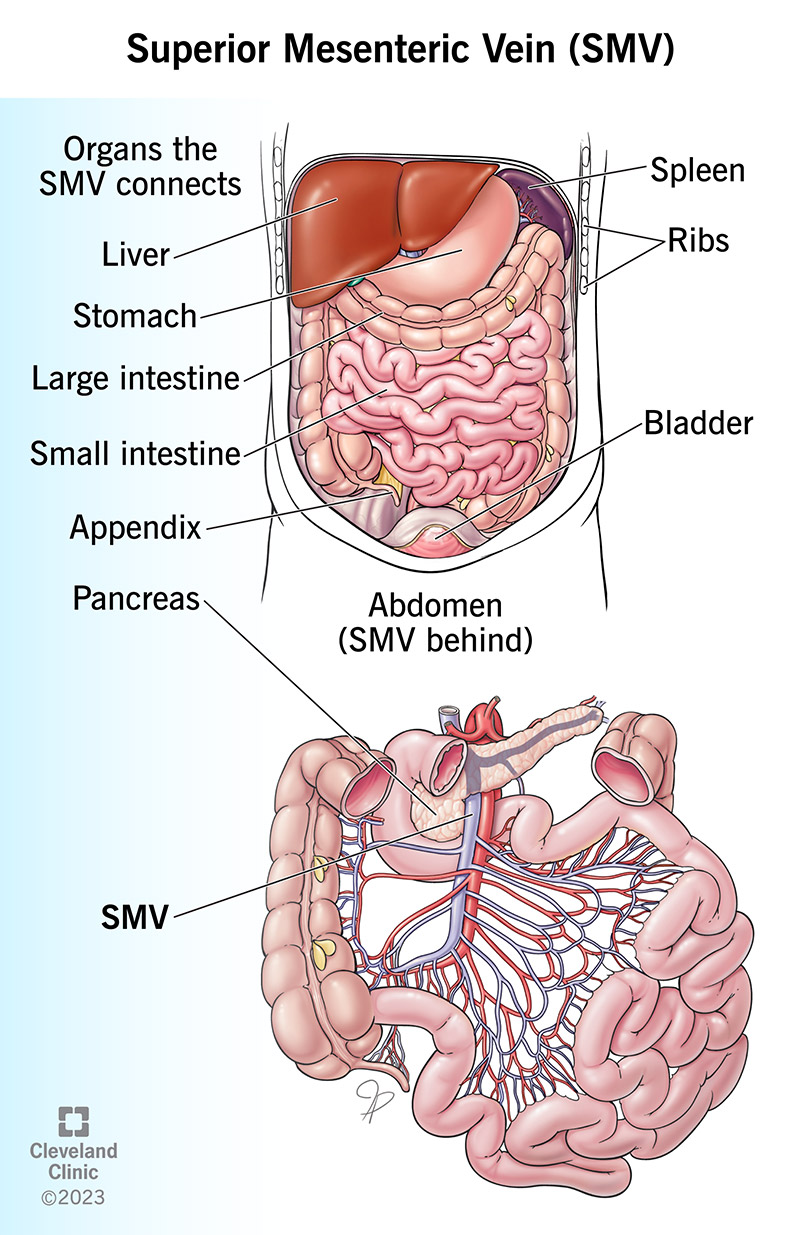Your superior mesenteric vein (SMV) is a blood vessel in your portal venous system that helps blood travel from your intestines to your liver. Your SMV collects blood from many tributaries in your belly and supplies it to your portal vein. Your portal vein empties the blood into your liver for processing before it flows back to your heart.
Advertisement
Cleveland Clinic is a non-profit academic medical center. Advertising on our site helps support our mission. We do not endorse non-Cleveland Clinic products or services. Policy
Your superior mesenteric vein (SMV) is a blood vessel that helps carry blood from your intestines to your liver. It plays an important role in the distribution of blood in your abdomen (belly) and ultimately your entire circulatory system.
Advertisement
Cleveland Clinic is a non-profit academic medical center. Advertising on our site helps support our mission. We do not endorse non-Cleveland Clinic products or services. Policy
A blood clot or other disruptions to blood flow in your SMV can lead to serious complications. Therefore, it’s important to learn about your SMV and how it supports healthy blood flow in your body.
Your superior mesenteric vein supports the work of your hepatic portal system (portal venous system). This is a network of veins that drains blood from organs in your belly and sends it to your liver. Your SMV is one of the most important veins in this network because it collects blood from many other veins.
Your SMV is a bit like a tree branch containing many twigs. The twigs are smaller veins that serve as tributaries, carrying blood from nearby organs into your SMV. Together with its tributaries, your SMV drains blood from your:
Your superior mesenteric vein then supplies all this blood to your portal vein.
If you imagine your SMV as a tree branch, then you can think of your portal vein as the tree trunk. This trunk is “planted” in your liver through an opening called your liver hilum. Blood in your portal vein drains into your liver. Your liver then filters and processes the blood before sending it into veins that lead to your heart. Then, the blood flows through your heart and lungs and back out to the rest of your body.
Advertisement
The chart below lists tributaries of your superior mesenteric vein and what each one drains.
| Tributary of SMV | What it drains |
|---|---|
| Jejunal vein. | Small intestine. |
| Ileal vein. | Small intestine. |
| Ileocolic vein. | Appendix. |
| Right colic vein. | Large intestine. |
| Middle colic vein. | Large intestine. |
| Right gastroepiploic vein. | Stomach. |
| Inferior pancreaticoduodenal vein. | Pancreas. |
| Tributary of SMV | |
| Jejunal vein. | |
| What it drains | |
| Small intestine. | |
| Ileal vein. | |
| What it drains | |
| Small intestine. | |
| Ileocolic vein. | |
| What it drains | |
| Appendix. | |
| Right colic vein. | |
| What it drains | |
| Large intestine. | |
| Middle colic vein. | |
| What it drains | |
| Large intestine. | |
| Right gastroepiploic vein. | |
| What it drains | |
| Stomach. | |
| Inferior pancreaticoduodenal vein. | |
| What it drains | |
| Pancreas. |

Your superior mesenteric vein is in your abdominal cavity. This is the large space under your chest and above your pelvis that holds important organs and tissues.
Your SMV begins near your belly button, within the part of your mesentery that connects with your small intestine. (Your mesentery is a double layer of tissue that holds the organs in your belly in place.) Your SMV extends up to your L1 vertebra, which is the top bone in your lumbar spine. There, it connects with your splenic vein to form your portal vein.
Your superior mesenteric vein travels along the right side of your superior mesenteric artery. This artery delivers oxygen-rich blood to your intestines. Meanwhile, your SMV carries blood that’s lower in oxygen (but rich in nutrients) away from your intestines and toward your liver. Many of the veins and arteries in your body travel alongside each other in this way. Imagine a two-lane highway with traffic moving in opposite directions on either side.
Occasionally, the SMV travels along the left side of a person’s superior mesenteric artery. This anatomical variation can happen in babies born with malrotation. It can also happen if you have a tumor that presses on nearby structures, including blood vessels.
Like other veins in your body, your SMV has walls made of three layers:
Conditions that can affect your SMV include:
Learning anatomy can be exciting but also overwhelming. Don’t feel like you need to learn the terms and concepts all at once. If you’re learning about your SMV due to a medical diagnosis, remember that your healthcare provider is there to help. Ask them to explain concepts you don’t understand, and write down the key points. The more you learn about the inner workings of your body, the more you’ll feel comfortable talking to your provider about your condition and what you can expect going forward.
Advertisement
Cleveland Clinic’s primary care providers offer lifelong medical care. From sinus infections and high blood pressure to preventive screening, we’re here for you.

Last reviewed on 08/03/2023.
Learn more about the Health Library and our editorial process.